Zoom audio quality is important for communicating effectively during Zoom meetings, but many users experience common audio issues like unwanted noise, echo, or unclear sound.
In this article, we'll explore how to improve Zoom audio quality by addressing factors like internet connectivity, microphone positioning, and background noise to achieve superior audio results for Zoom meetings and recordings.
Reasons Why Zoom Audio Quality Might Be Poor
Poor Zoom audio quality can be caused by several factors related to both software and hardware. Users often overlook important audio settings in the Zoom app or rely on suboptimal computer audio configurations, leading to interference, unclear speech, or distorted audio.
Here are some issues that frequently impact audio on Zoom calls and recordings:
Inadequate Microphone Quality
One of the most common reasons for poor Zoom sound quality is using a low-quality microphone.
Many users rely on the microphones built into their laptops or webcams, but these tend to have poor audio quality and pick up excess noise. They can produce static, echo, or unclear speech, making it hard for listeners to follow the Zoom meeting conversation.
Background Noise Interference
Background noise is another common cause of poor Zoom sound quality. Noise from fans, air conditioners, traffic, street noise, or surrounding people can disrupt audio during a Zoom meeting.
Zoom has built-in features to suppress background noise, but these aren't always enough to combat loud or consistent noise. The suppression effect may also distort your speech, forcing you to trade off vocal clarity against background noise. Or it may work sporadically, cutting off certain words in spoken sentences.
Internet Connectivity Issues
Zoom calls rely on an adequate and stable bandwidth, so a poor internet connection, weak Wi-Fi signal, or network congestion can make your audio choppy, distorted, or delayed. Audio is sensitive to bandwidth fluctuations, and even slight interruptions can result in an inconsistent audio experience.
Zoom generally requires an internet speed of at least 1.5 Mbps for high-quality audio, but faster speeds will ensure a more reliable performance. You can check your internet speed using online tools.
A wired internet connection or a strong Wi-Fi signal will help to provide a more stable and consistent signal.
Incorrect Microphone Positioning
Microphone placement can significantly affect your audio experience in a Zoom meeting. If your microphone is too far away or misaligned, it may not capture your speech properly.
Built-in microphones are more susceptible to audio issues when speaking too close or too far away from them, resulting in muffled, distorted, or overly quiet speech.
Your microphone's pickup pattern will also impact your Zoom audio experience. If your microphone is directional, the angle between your mouth and the microphone will affect how your voice is captured. If your microphone is omnidirectional, it may pick up additional surrounding noise.
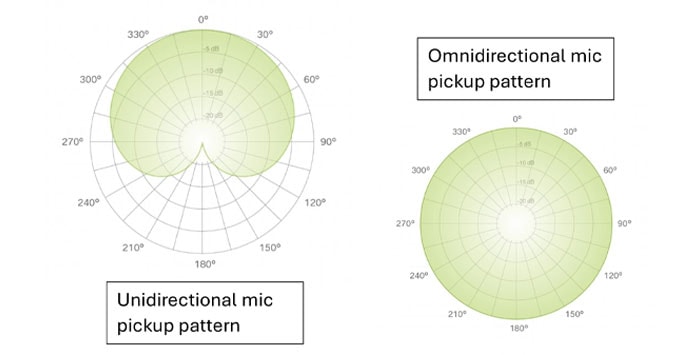
Windows Audio Device Drivers Affecting Sound Quality
Audio device drivers included with your Windows software can degrade Zoom's audio output.
These drivers manage the communications between your computer's hardware and its operating system, so outdated or corrupted drivers may cause distortions, echoing, or complete audio loss during a Zoom call.
Drivers may also fail to integrate with external microphones or headphones, further affecting audio quality. Ensuring your drivers are up-to-date and reinstalling them when necessary will help to resolve these issues.
9 Methods to Improve Your Zoom Audio Quality
So, how can you avoid or minimize audio issues with your Zoom calls and recordings?
In this section, we'll look at 9 easy methods to improve your zoom audio quality.
Where I've included step-by-step instructions for Zoom below, I've used Zoom Workplace. This is Zoom's latest collaboration platform, incorporating a range of applications and the latest version of Zoom's video conferencing software. Some steps may differ from your version of Zoom if you're not using Zoom Workplace, but the logic flow should be similar.
Use A High-Quality External Plug-in: CrumplePop Voice Enhance
If you've recorded a Zoom call and are unhappy with its audio quality, the easiest and most effective way to improve its sound is to use a high-quality external plug-in like CrumplePop's Voice Enhance (from Boris FX).
Voice Enhance is an AI-powered audio plug-in that uses advanced signal processing to improve clarity, suppress background noise, and apply echo cancellation in professional audio and video editing apps, including Premiere Pro, Audition, and DaVinci Resolve.
By activating and using Voice Enhance in your favorite app, you can dramatically improve the audio quality of your Zoom recording, making it clearer and more professional-sounding, even in noisy environments.
A key feature of Voice Enhance is its local functionality, so there's no need to upload files or wait for cloud processing. This gives you privacy and speed, which is ideal if you're a busy content creator looking to produce high-quality audio quickly and efficiently.
It's easy to use Voice Enhance in your favorite video editing app:
- Download and install Voice Enhance by visiting CrumplePop's website and following the installation instructions for your chosen app.
- Select Voice Enhance from your audio plug-ins.
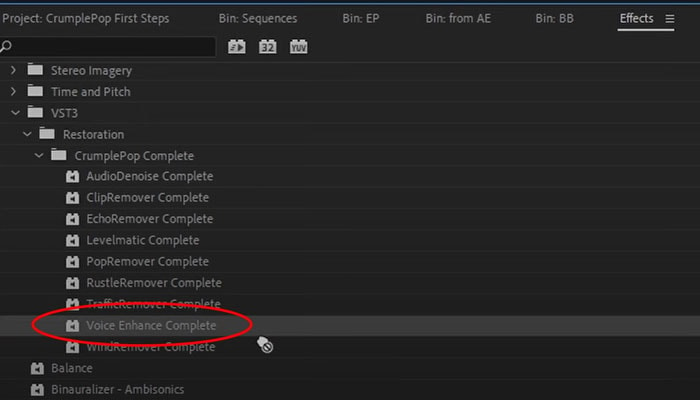
- Apply it to the audio track of your recorded Zoom video.
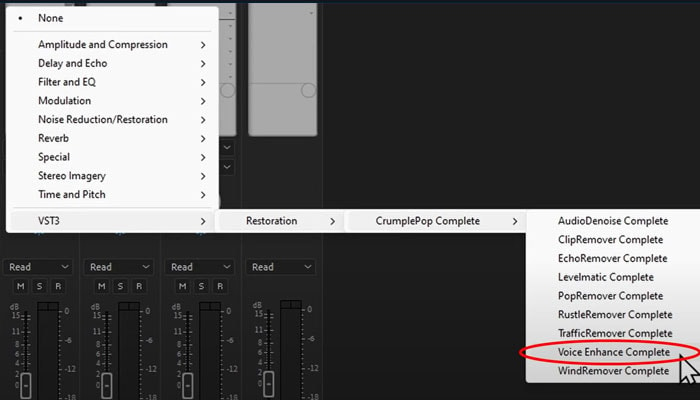
- Tweak its settings like Strength and Refine using the provided sliders to find your ideal sound, noting that Voice Enhance does a great job with its default settings.
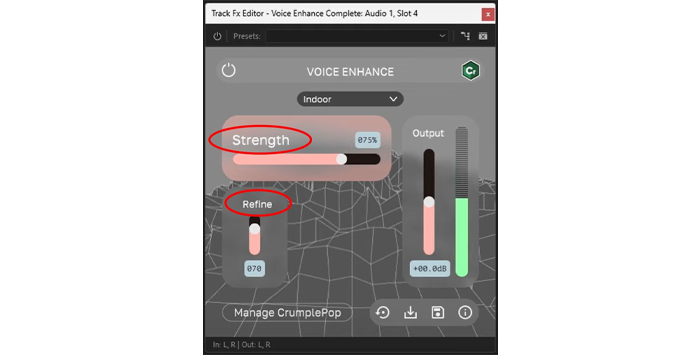
- Select your preferred voice model to optimize the enhancement applied based on the recording environment, choosing between Indoor, Indoor - noisy, and Outdoor.
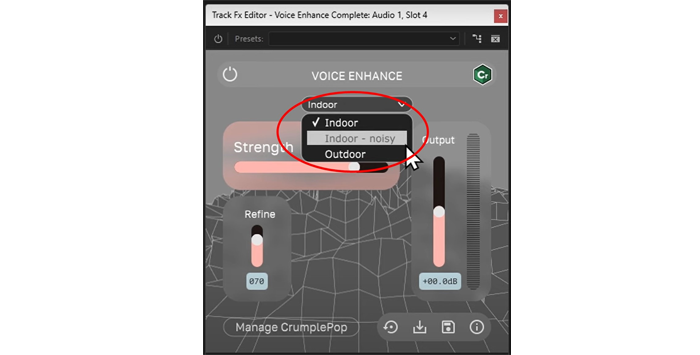
And there you have it! Voice Enhance easily transforms audio for your recorded Zoom calls to make them sound more professional and understandable.
Check out this helpful video guide for more information and helpful hints on using Voice Enhance.
Try Voice Enhance Now!
Instantly transform any voice recording into professional-quality sound with the power of AI. No internet access required- your audio stays private and secure. Toggle it on/off to hear the difference.
On-location Interview
Selfie-style Phone Audio
Zoom Call
Ridiculous Echo
Traffic Noise
Far from Mic
Untreated Room
Recording at Home
On-location Interview
Use A High-Quality External Microphone
Use an external high-quality microphone instead of your computer's built-in mic or webcam microphone to significantly improve your audio during Zoom meetings.
Microphones such as the Blue Yeti or Audio Technica AT2020 are popular choices for better vocal clarity.
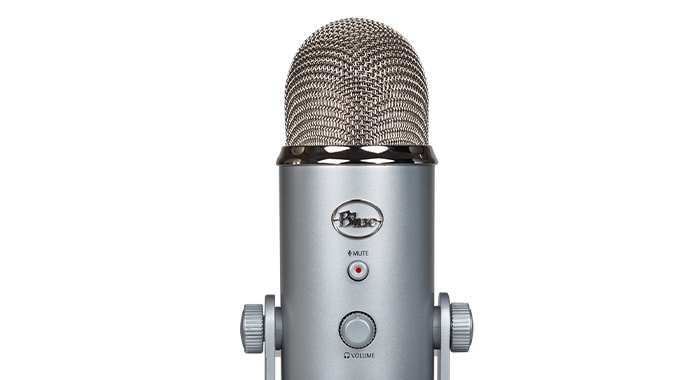
You can set up an external mic by adjusting your Zoom's sound settings as follows:
- Plug in the microphone.
- Go to Zoom Audio Settings.
- Select your external microphone under the input device.
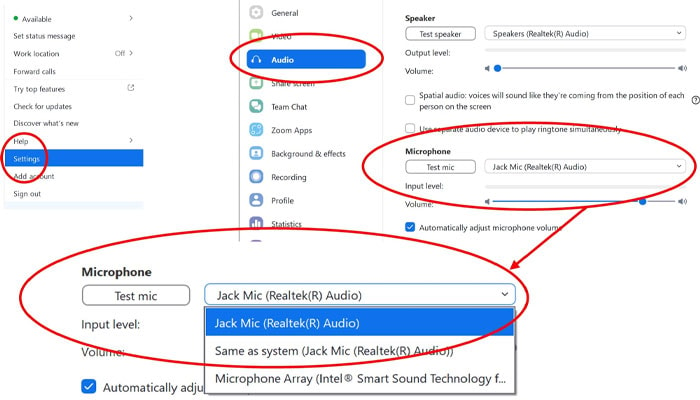
Position your external microphone carefully for optimal pickup. Place it 6–10 inches away from your mouth, depending on its sensitivity. Speak directly into the microphone, without blocking it with your hands or other objects, to ensure a consistent sound.
You may also wish to use a pop filter to minimize interference from plosive sounds caused by bursts of air when pronouncing letters like "b", "t", "p", and "k".
Pop filters are shields made from nylon or some other acoustically semi-transparent material stretched around a frame (typically circular) and placed in front of a microphone. They may also be made from a fine metal mesh, rather than nylon, and are often attached to a microphone's stand.
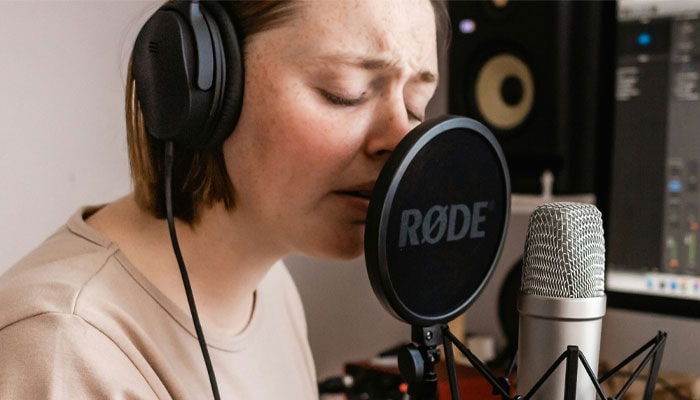
Pop filters minimize the impact of the air bursts produced by plosive sounds. Their nylon or metal meshes help dissipate the energy of the plosives, reducing the possibility of clipping audio. If they don't work well enough for your situation, or if you've forgotten to use one for a recording taken earlier, use a versatile plug-in like PopRemover to easily remove plosives in post-production.
Pay attention to minimizing sound picked up by your microphone from your computer or external speakers. Consider using headphones to avoid feedback loops and echoes, which can distort your audio. Headphones help isolate your voice and prevent external interference for clearer communication.
Optimize Your Internet Connection
A fast, stable internet connection with a sufficiently large bandwidth (measured in megabits per second or Mbps) provides uninterrupted audio and better internet speeds. This reduces audio lags, distortions, and delays.
To improve your audio quality when using the internet:
- Use a wired ethernet connection for more stability than Wi-Fi.
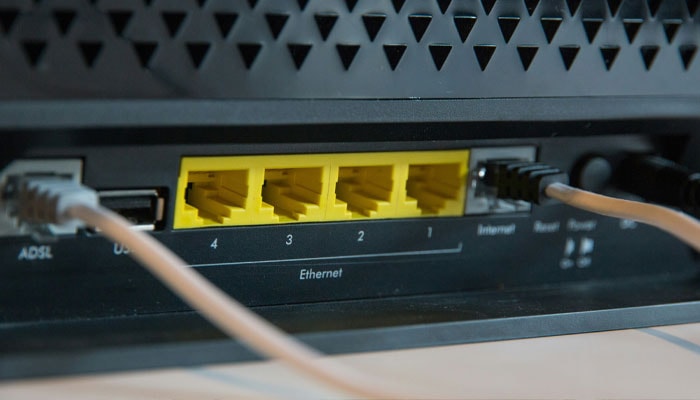
- Close unnecessary apps or browser tabs that consume internet bandwidth.
- If you're on Wi-Fi, move closer to your router or use a signal booster to improve connectivity.
- Use a wired ethernet connection for more stability than Wi-Fi.
Enable Zoom's Original Sound Feature
Zoom enables noise suppression, high-pass filtering, and automatic gain control by default, but sometimes these impact audio quality.
By enabling Zoom's Original Sound feature, you can preserve your voice's natural sound by turning off these automatic features. If you're using a good external microphone, Original Sound will also allow your full vocal characteristics to shine through without interference.
Enabling Original Sound provides an in-meeting toggle to switch the automatic features on or off. You can also choose to include any or all of the following:
- High fidelity music mode—for the highest quality vocal or music reproduction, but with higher CPU utilization and greater bandwidth.
- Echo cancellation—to prevent echoes from being captured or created.
- Stereo audio—to encode audio in stereo (provided a stereo-enabled microphone or audio interface is being used).
Here's how to set up Original Sound:
- Go to Audio Settings > Audio > Audio profile.
- Enable Original sound for musicians.
- During the call, select Original Sound to enable it.
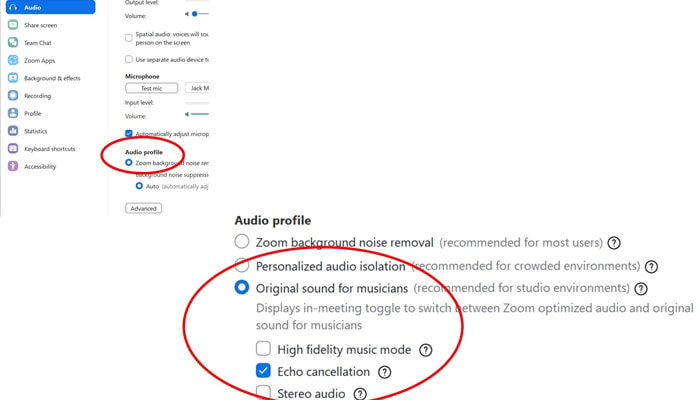
Use Noise-Canceling Software
If you conduct Zoom meetings in a noisy environment, external noise-canceling software can help filter out background noise and improve audio quality. Most noise-canceling software products eliminate distracting noise, such as keyboard clicks, barking dogs, or nearby conversations.
Noise-canceling software is generally easy to download and use with Zoom and typically uses a process as follows:
- Download and install the software on the computer, tablet, or phone that you use for Zoom calls, to create a "virtual microphone" or similar device, depending on the type of your software.
- Select the device in Zoom, following any instructions provided by the software vendor.
- Activate the device to experience fewer external noises during your Zoom meetings.
Use An External Audio Interface
An external audio interface significantly boosts your audio by allowing you to connect professional-grade microphones and other audio equipment to your computer's audio input.
Audio interfaces bypass the limitations of your computer's built-in sound card—which often lacks the power and precision needed for high-quality audio processing—to produce better, clearer audio. You also gain greater control over input levels, clarity, and audio fidelity.
Popular interfaces, like the Focusrite Scarlett series, offer multiple features and audio processing options, enabling precise adjustments and better control of your audio.
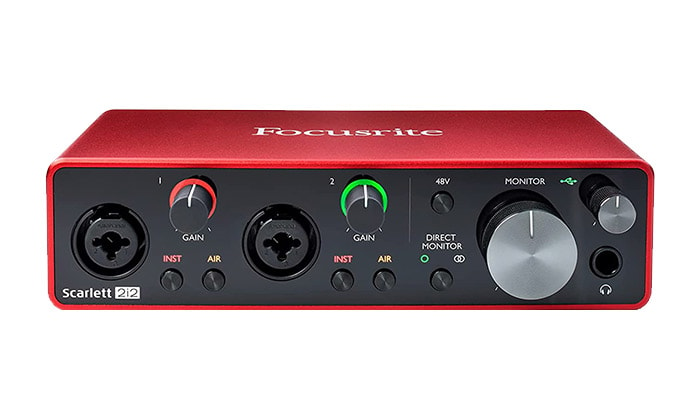
Record Separate Audio Files
To improve your post-production sound quality, record audio files for each participant of a Zoom meeting separately. This lets you edit each participant's audio later to remove background noise or enhance vocal clarity without affecting the entire recording.
You can set up Zoom to record separate audio files by going to Settings > Recording and selecting Record a separate audio file for each participant.
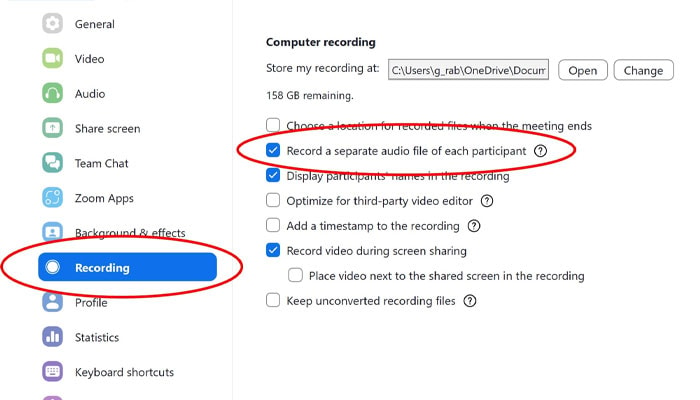
Use Zoom's High Fidelity Music Mode
One of the selections in Zoom's Original Sound feature is the option to capture high quality audio and detailed voice recordings with Zoom's high fidelity music mode. This is useful for podcasters, in a recording studio environment, or for anyone wanting a richer, more nuanced sound during Zoom calls.
Keep in mind that this mode may increase CPU utilization and consume greater network bandwidth, so it's best used with a wired ethernet connection.
Here's how to set it up in Zoom:
- Go to Settings > Audio > Audio profile and enable Original sound for musicians (to select Original Sound).
- Check the box for High fidelity music mode.
- During the call, select Original Sound to enable it.
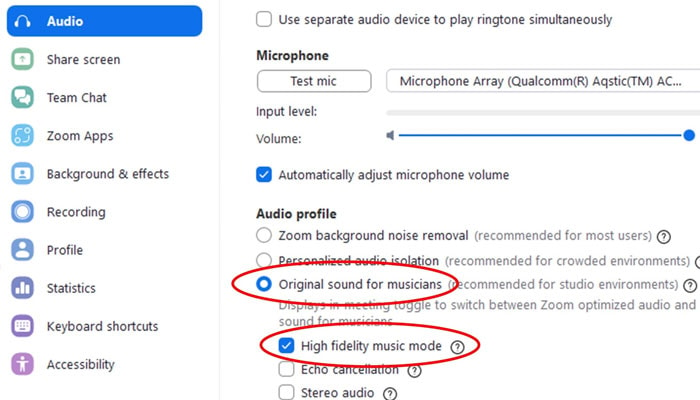
Use Acoustic Treatments for Your Meeting Space
If your meeting space suffers from echo or reverberation, try treating it acoustically. This is a cost-effective, long-term solution for improving the quality of your Zoom meeting audio.
Hard surfaces reflect sound, causing echos that may distort your speech, whereas soft surfaces absorb sound and reduce reflections.
Add items like rugs, curtains, or foam panels to soften the surfaces in your room.
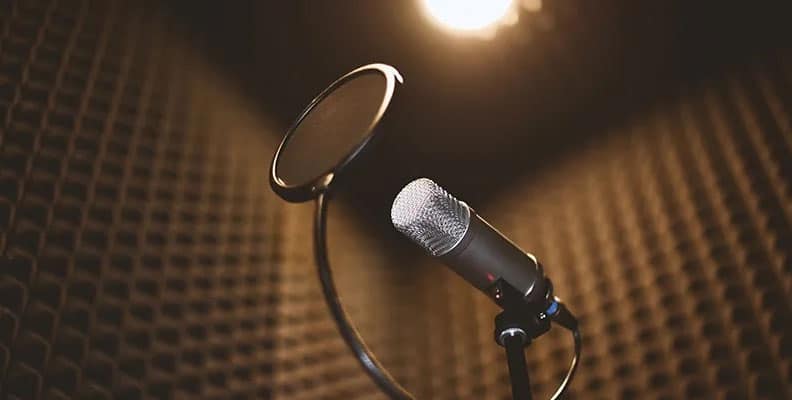
Try this approach:
- Identify the areas in your room that create echos, typically around walls, ceilings, floors, or other hard surfaces.
- Add acoustic foam panels to walls or ceilings and use thick curtains or rugs in other areas to absorb stray sounds.
- Re-test your audio after each adjustment to gauge the level of improvement and re-adjust if necessary.
Final Words
Zoom audio quality is important for clear communication and a professional experience during virtual meetings. In this article, we've looked at how to improve Zoom audio quality by eliminating or minimizing common audio problems.
For the best audio experience, invest in tools like audio interfaces or sophisticated AI-powered plug-ins such as CrumplePop Voice Enhance to significantly elevate the quality of your Zoom call or final recording.
These steps will help you achieve a professional sound in every Zoom meeting, ensuring audio problems won't detract from your video conferencing conversations.
FAQs
How to improve the quality of recorded audio in Zoom?
One of the best ways to improve the quality of recorded audio in Zoom is to use a high-quality external plug-in like CrumplePop Voice Enhance. This AI-powered tool enhances vocal clarity, reduces unwanted noise, and eliminates echo, helping you achieve professional-sounding recordings, even in challenging acoustic environments.















